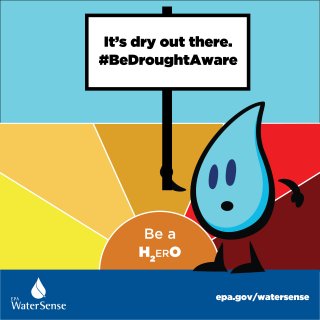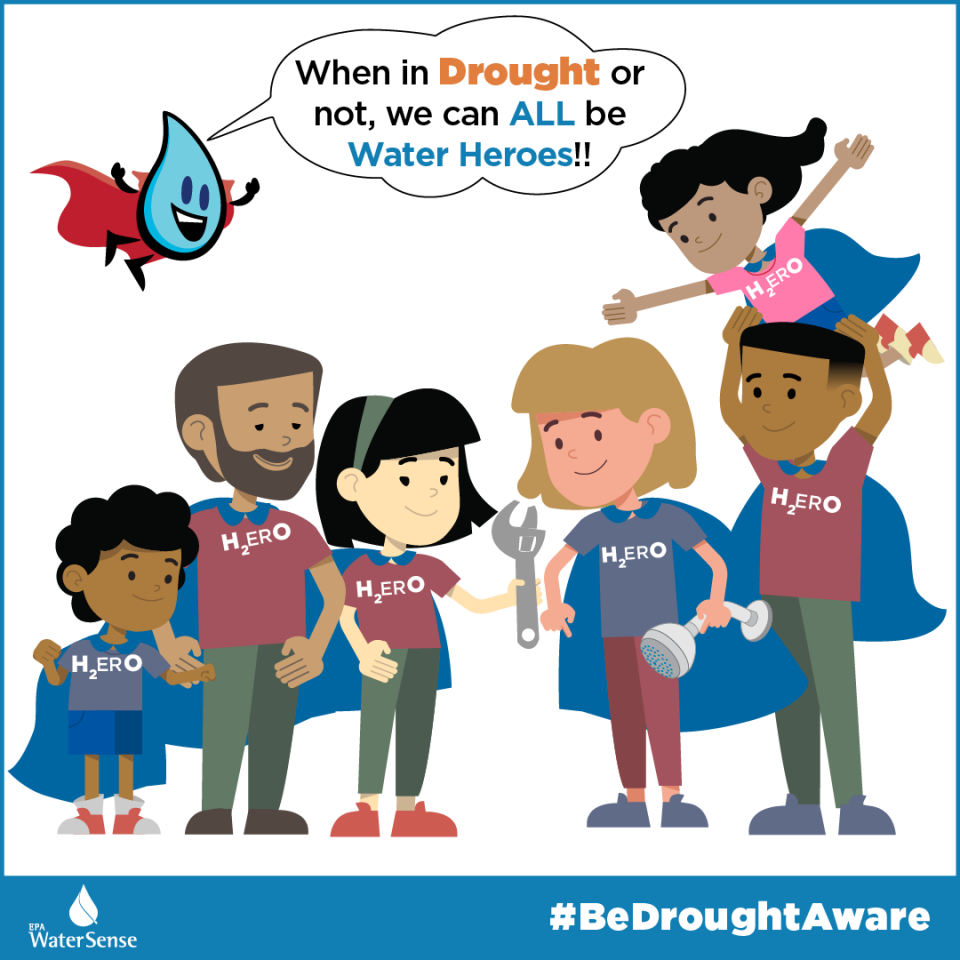Be Drought Aware

Droughts vs. Water Shortages
Droughts happen when there are long periods of abnormally dry weather with less rain or snow. They are sometimes referred to as slow-moving disasters because, unlike hurricanes or earthquakes, they take time to develop and happen over a longer timeframe.
Water supplies can be affected by drought because sources are not replenished with water from rainfall or snowmelt. Hotter temperatures can also increase evaporation from reservoirs and other surface water sources. Even groundwater can be affected by drought because there is less water percolating into the ground to recharge aquifers or because groundwater well pumping has increased to replace water provided by depleted surface water sources. Wells may go dry or have be drilled deeper to reach water.
Does a drought mean that your community is facing a water shortage? Maybe. Some utilities may get water from a location that is farther away where drought might not be a problem. Alternatively, if the distant area from which your water comes is in drought, your utility may ask that you conserve water even if conditions in your local area are not dry. Many utilities are working to develop a portfolio of water resources, so that if one is limited, they can access another source that may still be available. Water utilities are constantly monitoring their water supplies to help them make decisions on whether they need to declare a water shortage and ask their customers to conserve water.

Your water utility may have a drought/water shortage plan that includes several stages – with each progressive stage asking customers to do more to save water. At Stage 1, they may just suggest that you look for opportunities to save water. For a higher stage, they might restrict the number of times a week you can water your yard. At the highest stage, they might disallow all outdoor watering or close pools.
It is important that you make sure you are drought aware and paying attention to what your water utility asks of you because they are doing it to preserve your local environment and protect the health and safety of your community by saving water resources to meet the most important needs.
It's Dry out There! Be a H2erO and Do Your Part to Save Water!
When it's dry, it may mean there is a drought that can lead to water shortages. How can you be drought aware? Follow the steps below!
-
It’s Dry Out There! (PDF) Is there drought in your area and, if so, how bad is it?
- Go to drought.gov and type in your zip code to see what the conditions are in your area.
-
Do you know the name of the water utility that provides you water?
- Look at your water bill (paper or online) and visit their website.
- If your utility has a portal to provide you information about your water use, sign up for it! It may also be able to let you know if you have a leak.
-
Do you know the source of your drinking water? Does it come from a reservoir, lake, river, or ground water? All of these sources can be impacted by drought!
- Your water utility should have information to tell you about the source of your drinking water.
- Note that you might learn that your water comes from far away, where drought conditions may be different than where you live.
-
Do you know how much water your household uses every month?
- Look at your water bill, it should tell you how much water you use every month. The units may be in gallons or CCF (hundreds of cubic feet ; 1 CCF= 748 gallons).
- If you want to know more about how to understand your water bill, visit this page.
-
Have you compared your winter and summer water use to get a sense of how much more water you use in the summer?
- Water use is usually higher in the summer because of landscape watering and can cause problems when there is a drought. Think about how you can cut back on landscape watering.
-
Have you checked for where you might be wasting water - indoors and outdoors?
- Do you have any leaking toilets and faucets or broken sprinklers? Those little leaks can add up to hundreds or thousands of gallons wasted every year.
- Check the WaterSense Fix a Leak Week tools to see how to look for leaks in your home.
- Check the WaterSense Sprinkler Spruce-Up tools to help guide you through a landscape and irrigation inspection.
-
Have you replaced older toilets, faucets, or showerheads to updated, water-saving WaterSense labeled products?
- WaterSense labeled products will use less water and perform as well or better than standard models. Your utility may provide rebates to help you save money.
-
Are you following the directions provided by your utility?
- This is the most important thing to do if you want to be drought aware! Your utility may ask you to take steps to reduce water use, maybe by changing how often you water your yard.
- They are only asking you to do this because it's important - it will allow them to have enough water to provide critical services to your whole community.


